If you want to see orangutans in Borneo, one of the best places to do it is at the Tanjung Puting National Park in Kalimantan, Indonesia.
The jungle at Tanjung Puting is home to hundreds of Borneo’s animal species, including some rare and endemic ones, and you get to see all of this while staying on a ‘Klotok’ houseboat as it winds along the Sekonyer river.
We spent 3 days and 2 nights on a liveaboard boat at Tanjung Puting and it was amazing. It’s not one of the cheapest places to visit in Indonesia, but the whole experience is really unique and special.
This travel guide will explain how to get to Tanjung Puting and see the orangutans, which boat tour company to use, and everything else you need to know before you go!

Mom and baby orangutan
How To Get To Tanjung Puting National Park
Tanjung Puting is located on Borneo island, in the Central Kalimantan province of Indonesia, and if you look at it on a map it’s actually on the southern tip of the island.
The nearest town and airport is Pangkalan Bun (PKN), and there are direct flights every day from Jakarta, Surabaya, and Semarang. If you’re coming to Tanjung Puting from Bali, then you’ll have to transit in one of those airports on the way to Pangkalan Bun. You can shop for flights on Skyscanner.
Once you arrive in Pangkalan Bun, it’s a 15 minute drive to the harbor in Kumai, and depending on your arrival time, you can usually go directly to the harbor and start your tour of Tanjung Puting National Park.
Most tour companies will pick you up for free from town or the airport, and then bring you to the harbor where your boat will be waiting. From there, you can reach the entrance of the Sekonyer river and the national park in less than an hour of boat travel!

The river boat cruise at Tanjung Puting is a great way to see wildlife

Baby orangutan
River Boat Cruise: What To Expect
Tanjung Puting is normally accessed by boat via the Sekonyer river, and this is done with an all-inclusive liveaboard boat called a ‘Klotok,’ which usually has a crew of at least 4 people: a boat captain, a deckhand, a tour guide, and a cook.
The river moves very slowly, so you don’t have to worry about seasickness, rapids, waves, or anything like that on your journey into the park.
Besides enjoying the wonderful views from the boat, you’ll also make several stops to get off the boat and go see animals in the jungle, which involves a bit of short, flat trekking.
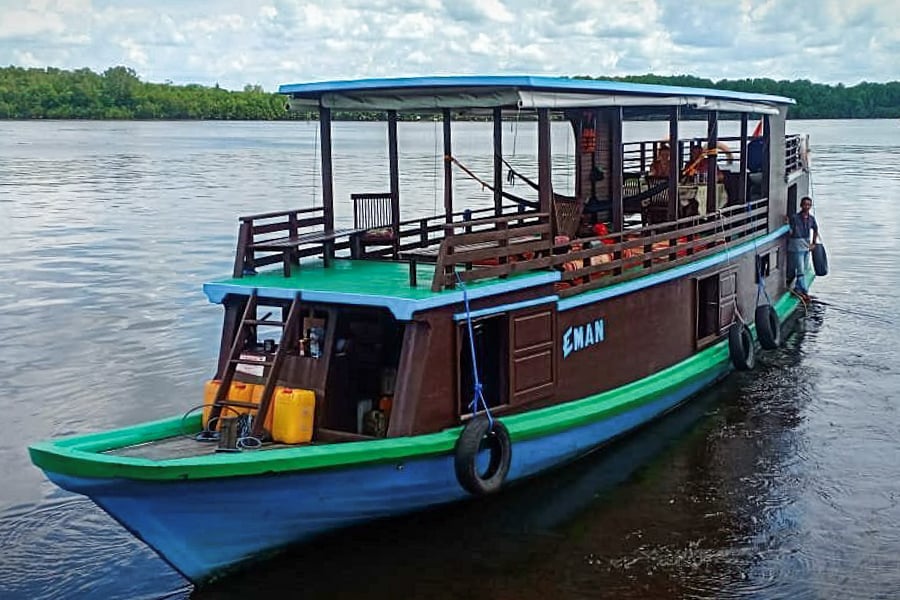
This is what the Klotok houseboats look like
The Klotok boats usually have space for up to 8 people in total, with the guests staying on the upper level while the crew lives in the bottom level.
Our boat had a reasonably comfy bed and bathroom, with a flush toilet and shower, although the facilities overall are pretty basic.
Think of it kind of like glamping. It’s not luxury, but it’s comfortable enough.
Meals are provided every day on the boat, and the food in our experience was great, including tempeh, omelets, toast, pancakes, fish, chicken, rice, noodles, soup, and all kinds of fruit and veggies. Everything we ate was fresh and good.
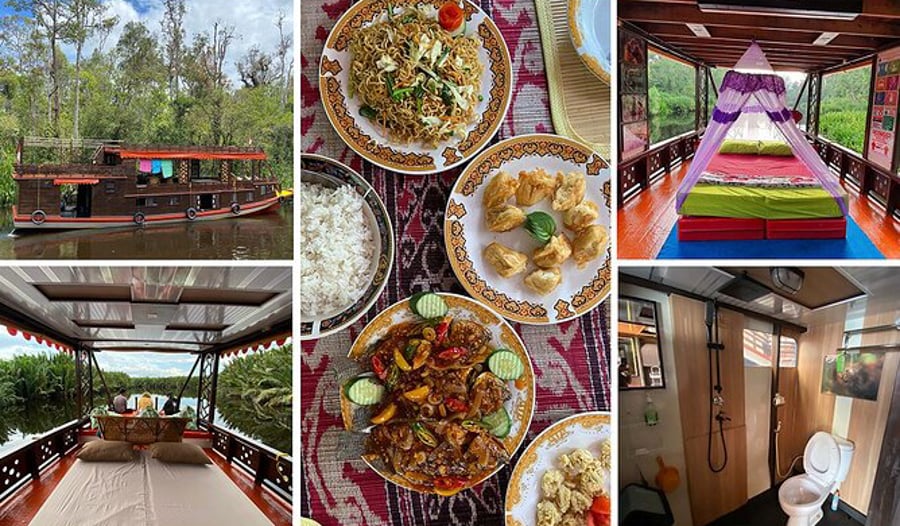
Life on the boat is pretty comfortable
Some Klotok boats have A/C, but most do not, and it’s not really needed. You may be hot and sweaty during the day, but at night the temperatures drop and it’s easy to cool off with a cold shower before bed.
Electricity is by generator in the evenings, so we were able to use the outlets to charge our phones and other electronics from time to time. It’s still a good idea to bring a fat power bank, though.
The boats have good rain covers so you don’t have to worry about getting wet either. We experienced a massive storm and downpour on our first night in the park, but everything in the boat stayed safe and dry.
Tours at Tanjung Puting typically last 2 or 3 days, but you can stay longer if you have the time and budget, or you can visit on a 1 day trip with a speedboat if you’re in a hurry.
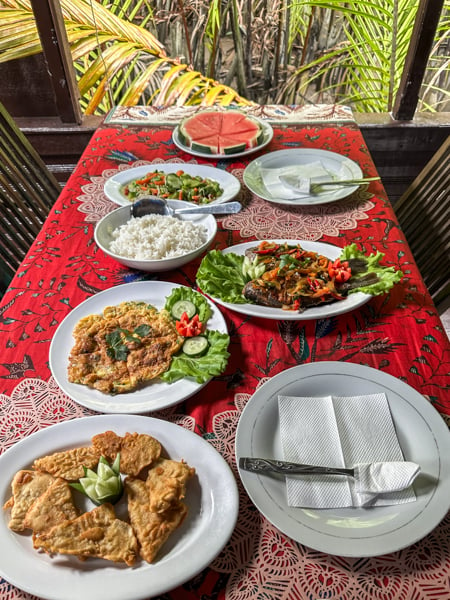
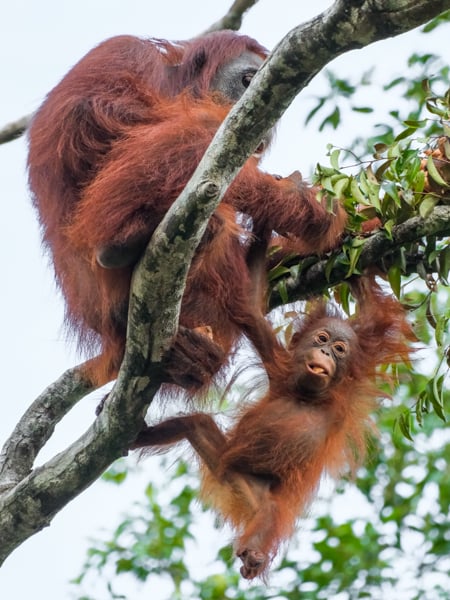
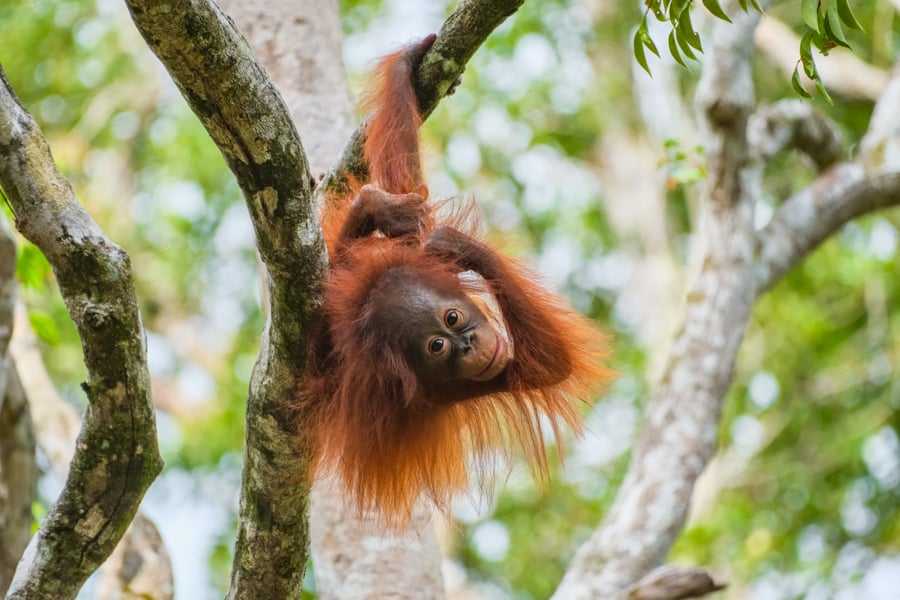
Upside down
• Day 1: Tanjung Harapan
After about 2 hours of traveling along the river by Klotok boat, the first place you’ll stop and visit in the national park is a camp called Tanjung Harapan.
This used to be a rehab center for orphaned and rescued orangutans, but now it’s just a feeding station where they help the animals get supplemental food (mainly fruit) so they can thrive and stay healthy.
When we landed at Tanjung Harapan, it was still early since the feeding time starts at 3 PM. We used the extra time to walk around near the camp a little bit and spotted our first orangutan, an adult female climbing in the trees.
When it’s feeding time, the park staff puts a pile of fruit on a wooden platform and then calls the orangutans out of the jungle. Sometimes you have to wait a bit for them to show up, but then they come swinging through the trees and you can watch them eat while you stand behind a fence about 30 meters back.
We saw almost a dozen orangutans at Tanjung Harapan, including several juveniles, one baby, and a big adult male. After we went back to the boat, we were also lucky to spot a bunch of wild proboscis monkeys (aka long nose monkeys) across the river, staring at us from the treetops!
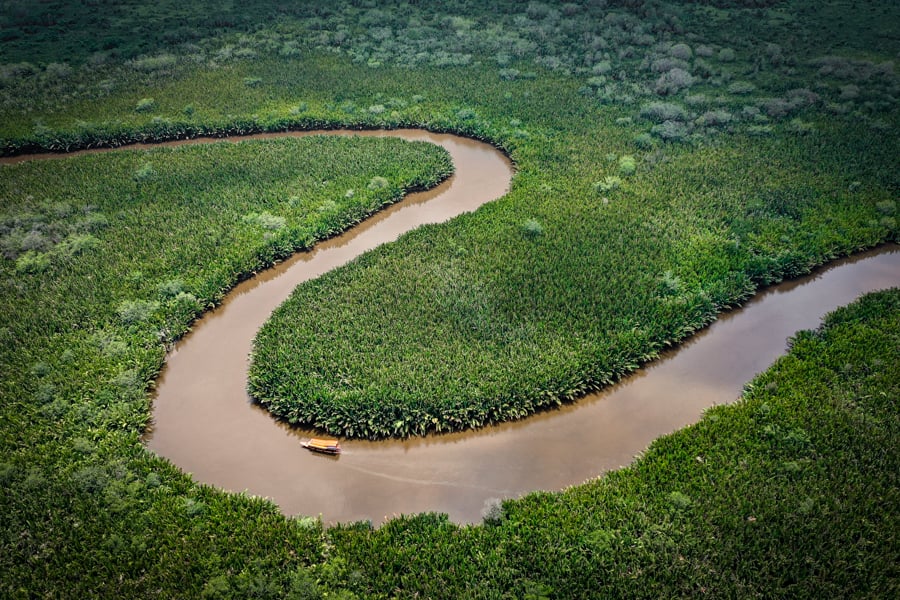
Drone picture of the Sekonyer river
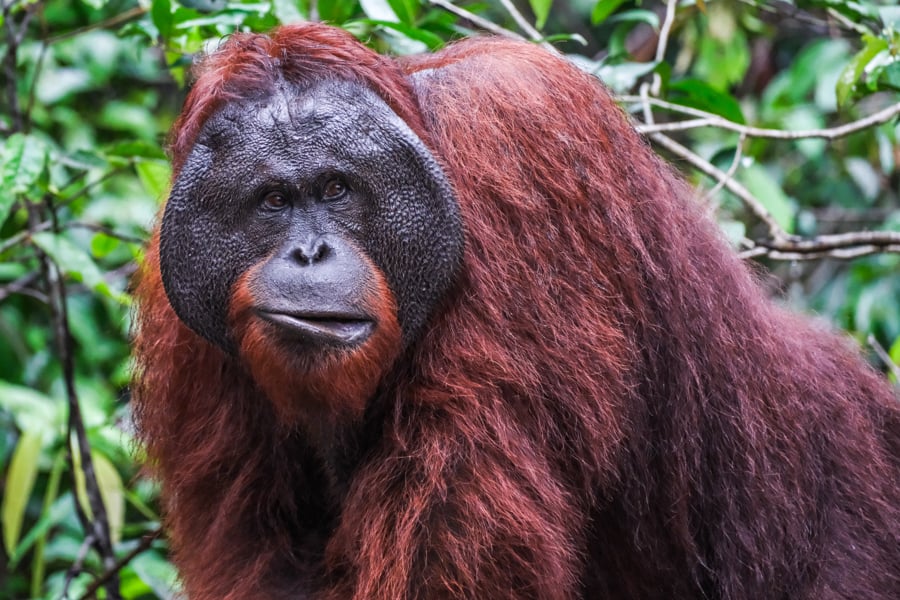
Big daddy orangutan
• Day 1: Night Trekking
At the end of your first day in Tanjung Puting, you normally have the option to do night trekking so you can see animals, plants, and bugs in the jungle near Tanjung Harapan.
In just an hour of flat and easy trekking, we saw a tarantula, pit viper, tree frogs, kingfishers, tokays, glow in the dark mushrooms, and lots of other interesting things.
The night trek is optional with most tours, but I’d highly recommend doing it if you still have energy left over at the end of the day!
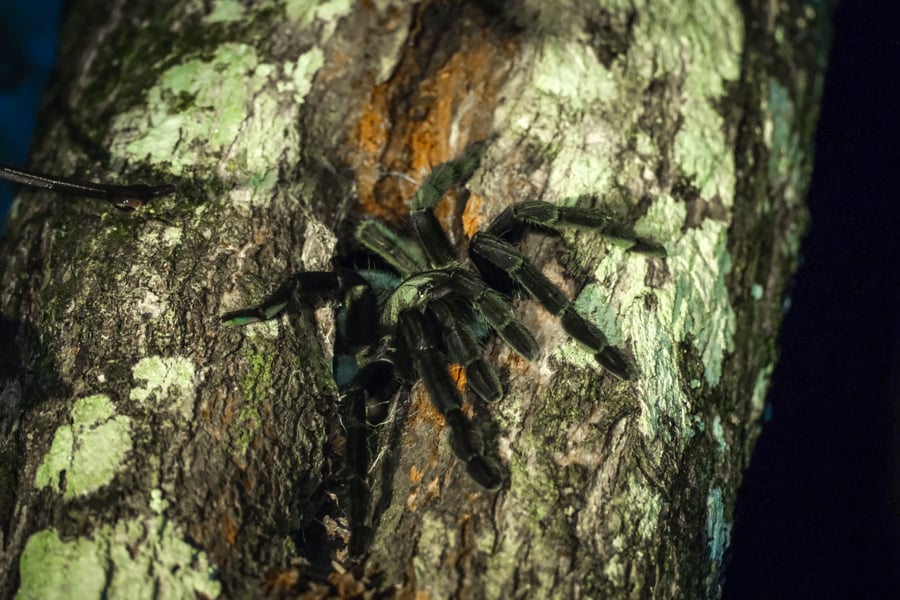
We saw this tarantula while night trekking

Kingfisher bird
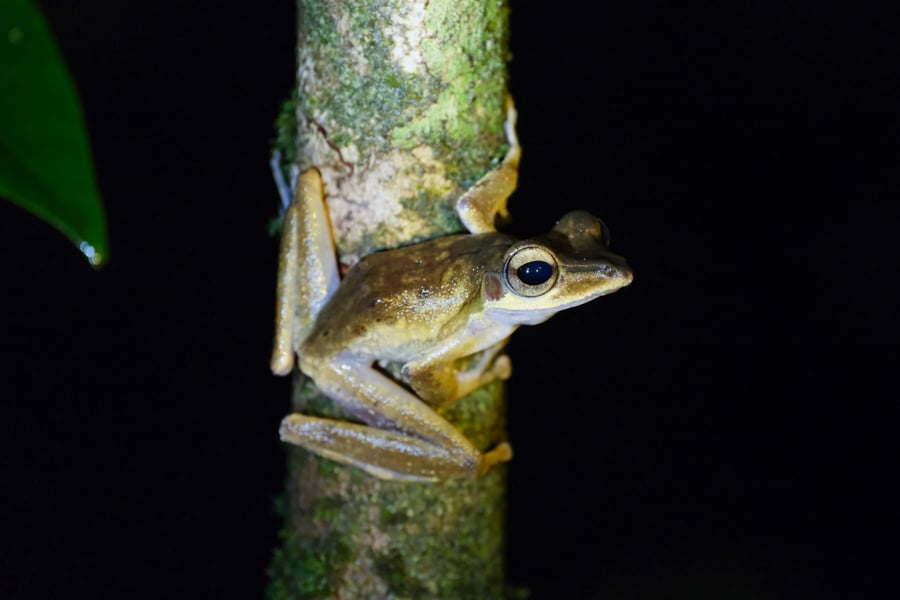
Tree frog
• Day 2: Pondok Tanggui
On our second day in Tanjung Puting, we woke up at 7 AM and drove the boat another 1.5 hours up the river to get to the next camp, which is called Pondok Tanggui.
Along the way, we saw some more wildlife in the trees, including proboscis monkeys, a crested serpent eagle, and a black-and-red broadbill.
We got to the camp just before feeding time, which starts at 9 AM. This time, we saw even more orangutans, including one very big and photogenic male orangutan who came at the end of the feeding time.
It was a good reminder to stay and wait a little bit after the feeding time ends, because sometimes the best animal sightings happen when the tourists have already started to leave.
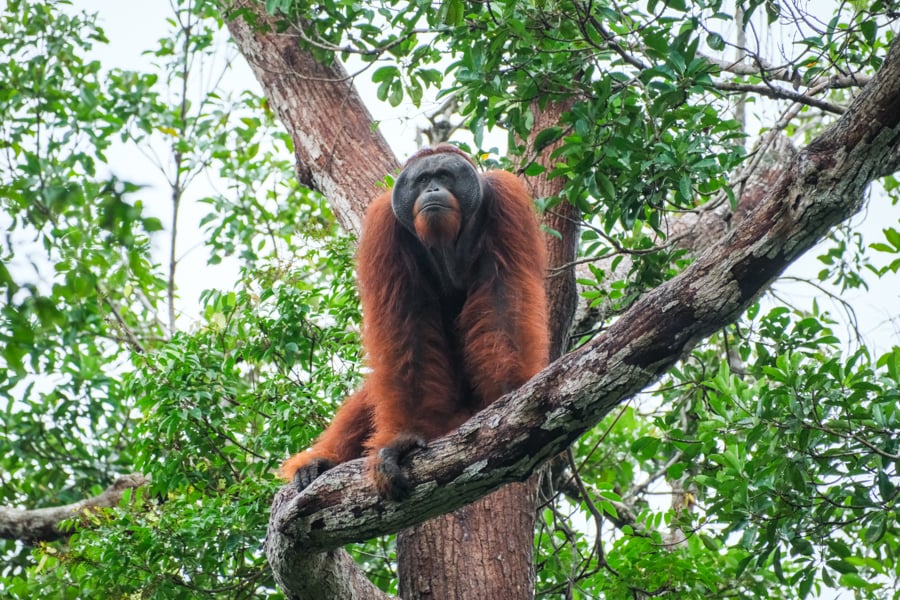
An amazing scene at Pondok Tanggui
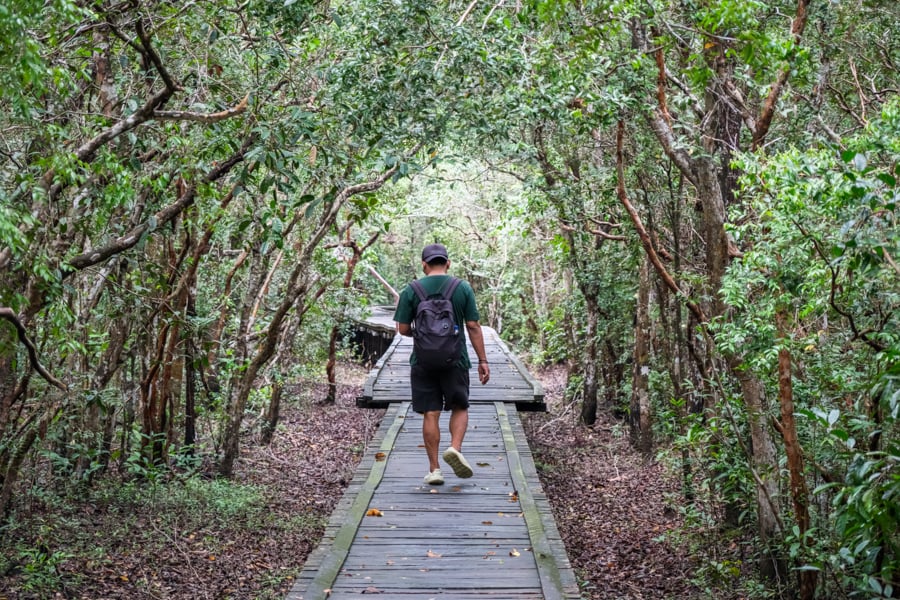
Each camp requires a bit of short and easy hiking to see the animals.
• Day 2: Camp Leakey
After we left Pondok Tanggui and got back on the river, the boat ride took approximately 2 hours to get to our next stop, which was Camp Leakey. The feeding time there is at 2 PM.
The color of the river at this point turns black because of chemicals from the plants, and the surface of the water is almost like a mirror reflecting the swamp. It looks spooky and beautiful.
We saw even more proboscis monkeys, and several macaques similar to the ones you might see in Bali. We also spotted a monitor lizard and a crocodile swimming around, although they disappeared before we could take any photos.
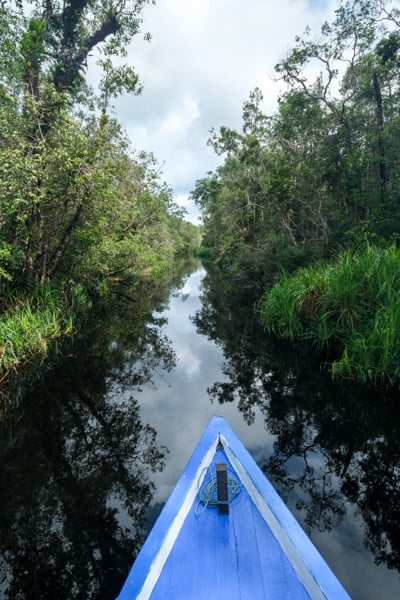
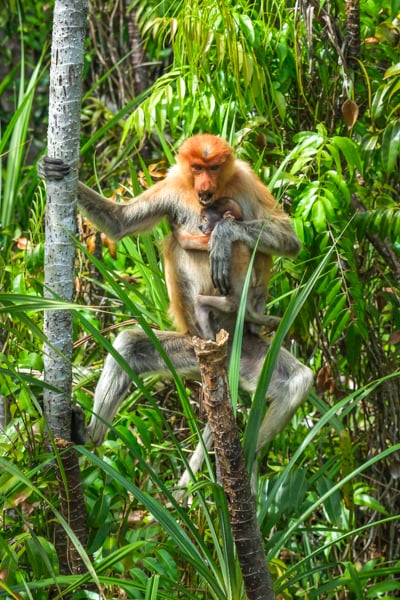
At Camp Leakey, we saw another dozen orangutans, but the highlight this time was seeing several mothers carrying babies.
The lighting and photo ops at this camp seem to be the best since the jungle isn’t quite as dense and dark as the first two camps.
After taking hundreds of orangutan photos, we went back to the boat and started the return journey to Kumai and Pangkalan Bun, stopping several times along the way to see more animals on the riverbanks.
We spotted lots of blue kingfisher birds and several families of proboscis monkeys, including a mother with a baby.
We drove most of the way back to town and then spent our second night near the entrance to the Sekonyer river, where there were lots of fireflies flickering in the palm trees. It looked kind of like blinking Christmas trees.
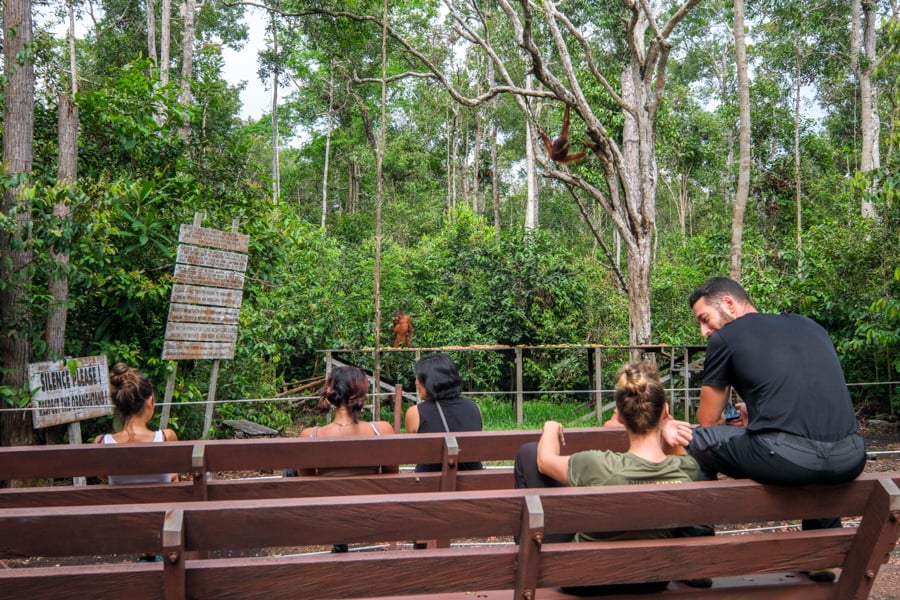
The feeding station at Camp Leakey
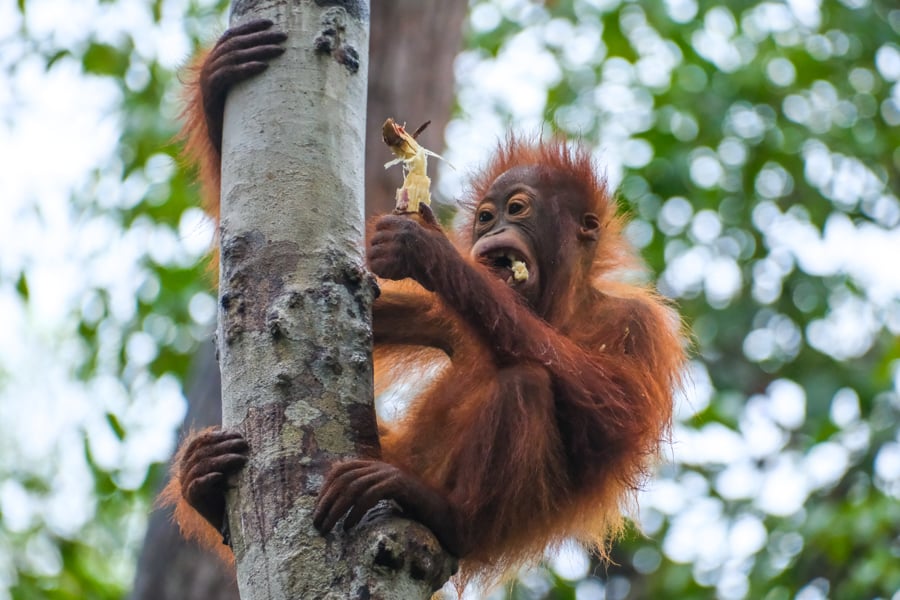
Juvenile orangutan snacking on sugarcane
• Day 3: Return To Pangkalan Bun
On day 3, we enjoyed a sunrise on the river and then ate breakfast before traveling approximately 1 hour back to the Kumai port, where we also had the option to visit a traditional Dayak longhouse near Pangkalan Bun.
This concluded our tour. Tanjung Puting was a wonderful trip filled with many memories! We wouldn’t change anything about our visit.
Wildlife At Tanjung Puting National Park
One of the main reasons to go to Tanjung Puting is to see wildlife. There are hundreds of animal species here, and you have a great chance of seeing many of them when you visit.
On our 3D2N cruise at Tanjung Puting, the main animals we saw were orangutans, proboscis monkeys, macaques, kingfishers, and hornbills, plus a crocodile and monitor lizard.
We also saw pitcher plants and all kinds of bugs, frogs, and reptiles when we did the night trekking.
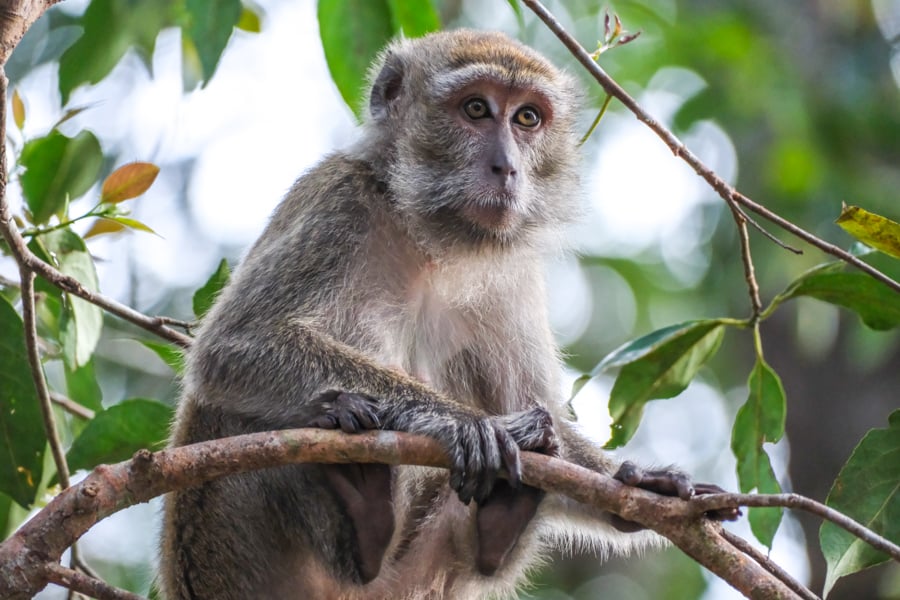
Long tailed macaque
I don’t want to scare you, but we even had a 4 meter python crawl into the lower level of our boat during the night, and the crew had to move it back to the river!
Needless to say, after that happened we always brought our flashlights with us when we’d go down to the bathroom at night. That was a free animal sighting we didn’t ask for, but since this is the jungle you never know what you might encounter.
If you’re lucky, it’s possible to see gibbons, leaf monkeys, tarsiers, clouded leopards, wild pigs, gharials, flying foxes, Sunda leopard cats, Asian sun bears, and many other things at Tanjung Puting, although your best chance of seeing these would be to do a longer trip where you can go further inland.
The national park covers an area of 4,150 square kilometers (1,600 mi²) so obviously you can’t see everything in a short trip, but you can see some of the best highlights.

Proboscis monkeys in the treetops
Orangutans At Tanjung Puting National Park
Of course, the star attraction at Tanjung Puting would have to be the Bornean Orangutans. You’re practically guaranteed to see orangutans here, and we saw almost a dozen orangutans on every day we spent in the park.
Tanjung Puting has the largest wild orangutan population in the world, with 30,000 to 40,000 of them living in its jungles.
The orangutans you’ll see at the feeding stations are semi-wild since they’re accustomed to seeing humans, but I wouldn’t say it’s a zoo-like experience at all. We encountered several orangutans far from the feeding areas.
You’ll see the orangutans climbing high into the tree tops, carrying their babies, and going about their daily lives, so there are plenty of opportunities to watch them in a natural setting.
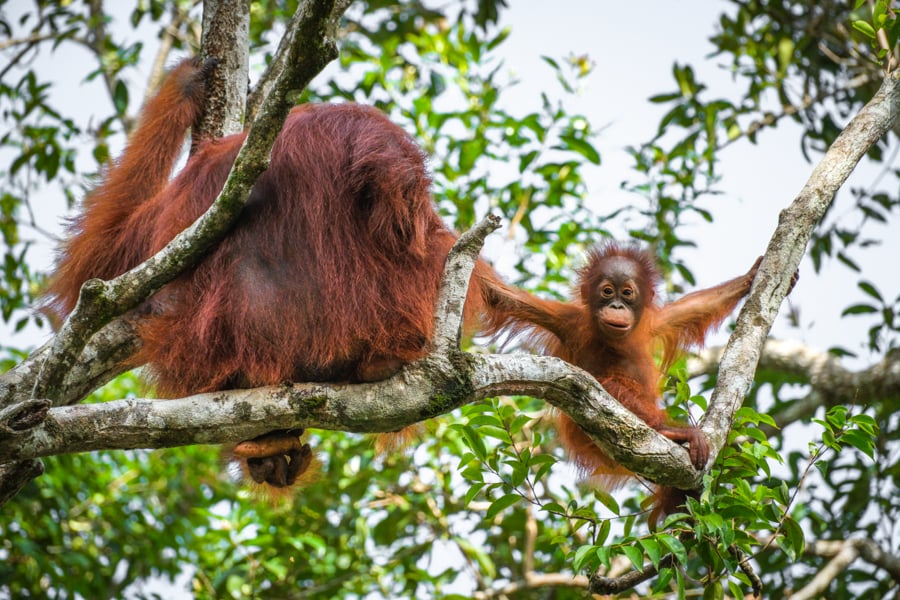
Mom and baby orangutan sitting in a tree
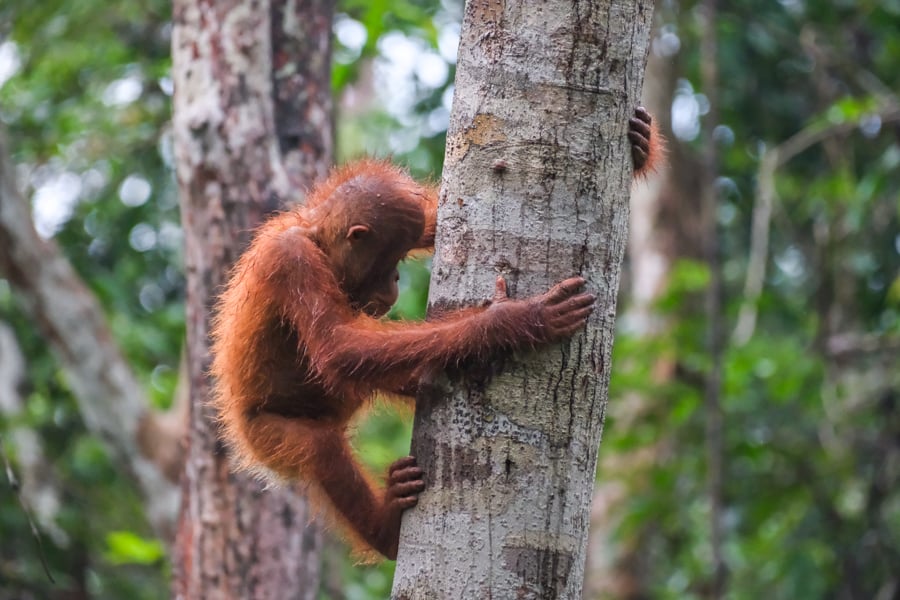
Learning how to climb
Is Tanjung Puting Worth It?
There’s no denying this place is expensive by Indonesian standards. You’re looking at around 11 million Rupiah ($700 USD) for an all-inclusive 3 day, 2 night private cruise for two people. It’s hard to find a tour any cheaper than that in 2024.
Part of the reason it’s expensive is because you’re using a big boat staffed by at least 4 people, and you’re traveling up and down the river for days while burning petrol. Then you have all the meals, national park fees, and other costs involved in the trip, so everything adds up.
Is Tanjung Puting worth it? Yes, I think so, but if you’re on a smaller budget and don’t mind trekking then I would do Bukit Lawang in Sumatra first.
Lawang is cheaper and you can see much of the same wildlife, including the orangutans, gibbons, leaf monkeys, etc. There are also a lot more things to do in that area of Sumatra.
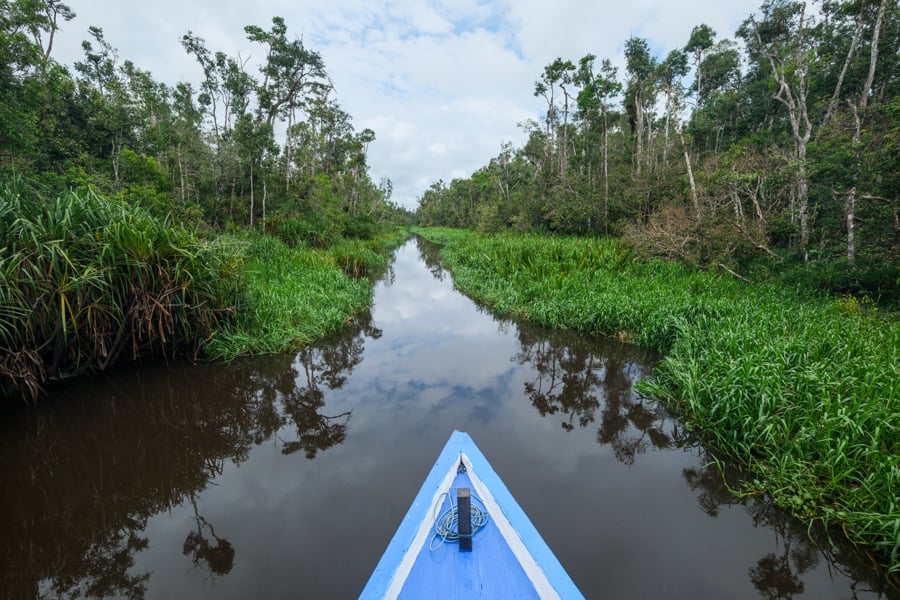
The black river
The main advantage of Tanjung Puting over Bukit Lawang is the river boat experience, which I have to say is phenomenal. It’s a very unique and enjoyable way to see the jungle.
Going to sleep at night with the bugs singing, watching the fireflies and the sunset over the river, and all of these other little details were special.
I loved sitting on the front of the boat with my camera, watching for wildlife all day as we churned through the river. There were tons of photo ops and the whole experience was loads of fun. I can’t say I’ve ever done anything quite like it.
The other advantage of Tanjung Puting over Bukit Lawang is the fact that the trekking is much easier for people who are old or unfit. When you’re trekking at Lawang, you have to deal with lots of steep ups and downs, muddy ground, and nasty thorns and leeches. It can be tough.
In contrast, Tanjung Puting has a little bit of short, easy trekking on raised boardwalks to reach each of the feeding stations, but almost anyone can do it.
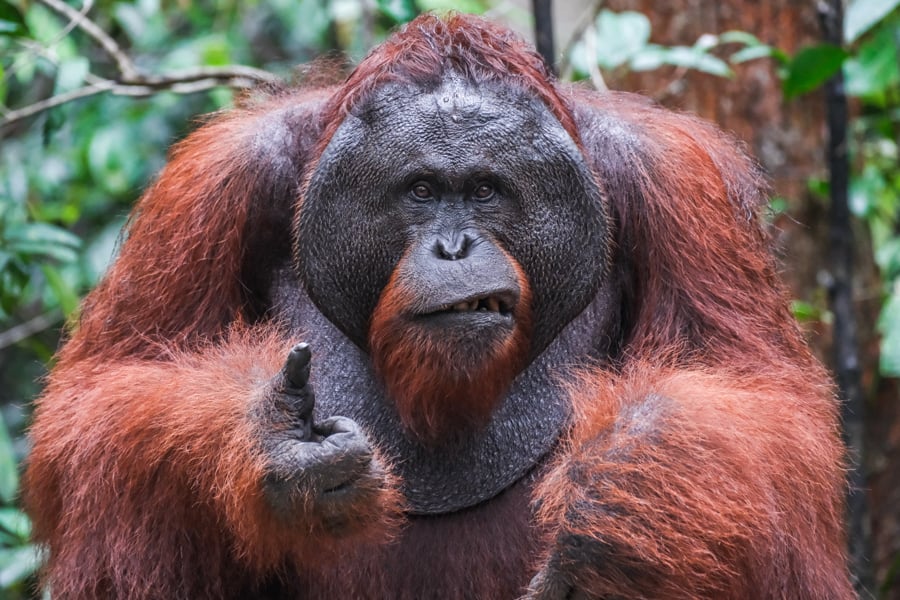
What is this expression?!
Best Tanjung Puting Boat Tour
Our top tour recommendation for Tanjung Puting would be Viator. They have high-rated 3 day and 4 day tours of Tanjung Puting, and they also have shared tours for solo travelers or honeymoon tours for couples.
Obviously these tours are pricey by Indonesian standards, but they’re comparable to the rates we saw on the ground. This 3 day tour is actually a better price than what we paid for our own tour, and we made a direct booking in Pangkalan Bun. Tanjung Puting is not cheap, unfortunately.
We’ve used Viator for lots of tours and activities around the world, and they’re great. Highly recommended!
Book Now: Tanjung Puting Boat Tour
Can You Visit Tanjung Puting Without A Tour?
Since Tanjung Puting is only accessed by the river, a boat tour is required. Generally that means doing a private tour unless you can find other travelers to share a boat, which isn’t always easy.
We tried to find an open boat to join when we went to Tanjung Puting, but we didn’t have any success, even though my wife is Indonesian and we asked lots of locals near the harbor. This was on a weekday in the low season, for reference.
You could probably find a shared boat if you go on a weekend in the high season (especially July and August), but there still aren’t any guarantees. This is one place where your options are pretty limited.
For that reason, I think it’s best to book a tour in advance rather than going to the harbor and trying your luck.
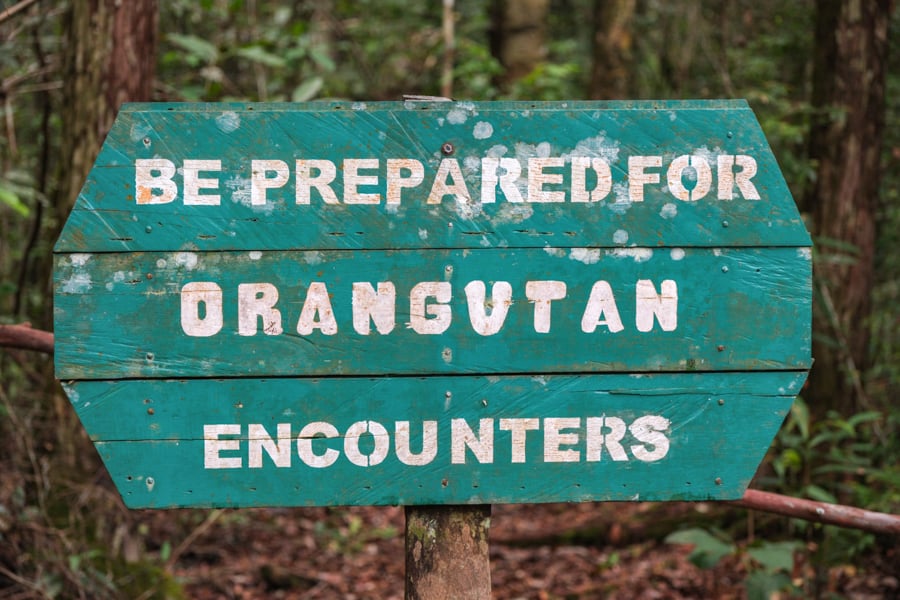
Sign near the harbor at Camp Leakey
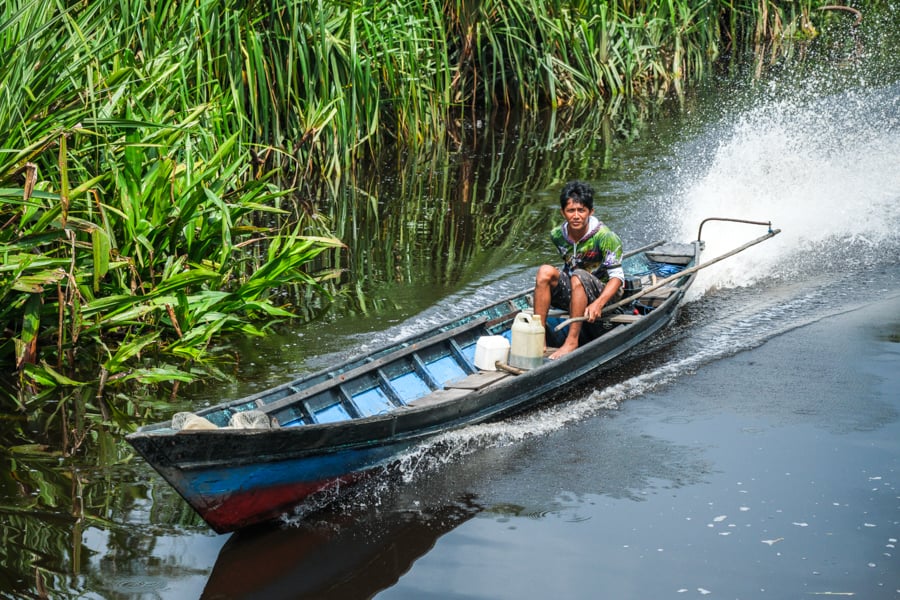
A local speedboat
Other Tips For Tanjung Puting
- Camera: Most of the time you’ll be at least 15 to 30 meters away from the orangutans and other animals, so a good zoom lens really helps here. I used a 70-300mm lens on a Fuji X-T5 (APS-C) camera. If you’re lucky, sometimes the animals will come closer to you.
- Cell Service: We had good 3G/4G signal with Telkomsel until we reached Tanjung Harapan, where we camped for the first night. We lost reception completely on the second day as we drove to Pondok Tanggui and Camp Leakey, and then didn’t have it until the third day, when we passed Tanjung Harapan again on the way back to town.
- Crocodiles: Do not swim in the Sekonyer river under any circumstances! There are crocodiles here and they’ve killed people in the past when they decided to take a dip. Even if you can’t see them, they’re lurking under the surface.
- Drones: The park doesn’t allow drones at the camps or anywhere near the orangutans, which is good. However, you can fly a drone from your boat when you’re cruising on the river. I coordinated this with my boat driver and was able to get some neat pictures of the river from above.
- Mosquitoes: Since this is a jungle, naturally there are plenty of mosquitoes. When the boat is moving there’s a nice breeze and they can’t come after you. However, when you get off the boat for trekking you’ll always want to spray yourself with repellant. Long sleeves would be a good idea too. When you’re sleeping at night, every boat company will provide a mosquito net for the bed. Double check and make sure. I wouldn’t go to Tanjung Puting overnight without a mosquito net.
- Malaria: According to this Lancet study from 2018, Malaria has been eliminated from Tanjung Puting and this area of Kalimantan, which is great news. Even so, I would still err on the side of caution and always protect yourself from bites. We didn’t take Malaria pills.
- Tipping: It’s not customary to tip for anything in Indonesia, but it’s always appreciated if you do. At Tanjung Puting, a nice tip for the guide would be something like 100k Rupiah per day spent on the boat, and 50k per day for the rest of the boat crew. Again, this is optional and not expected, but these guys do a great job so you’ll probably want to give them a little something extra.
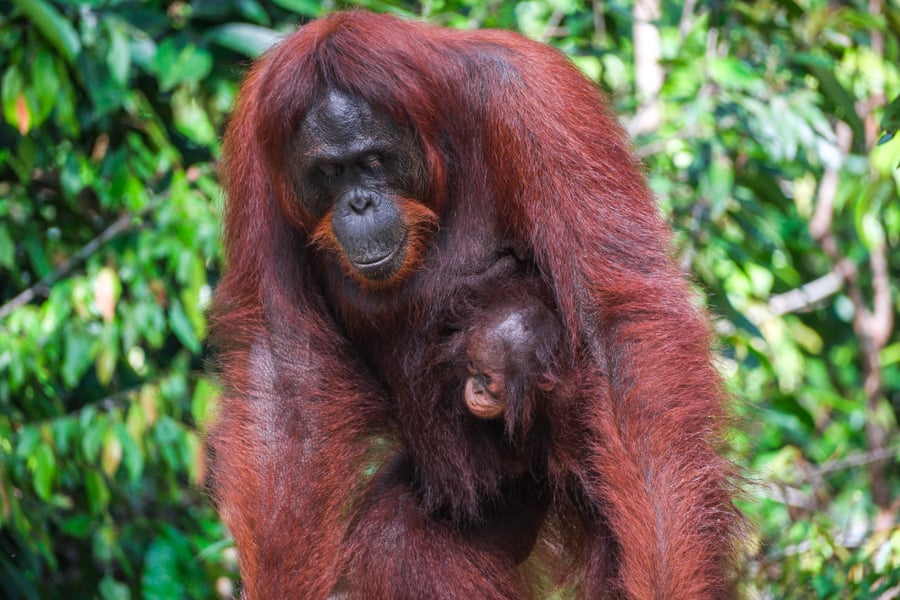
Mom and baby
Other Tips For Pangkalan Bun
- Cash: You can use your credit card to pay for your flights, hotels, and boat cruise, which should cover almost all of your expenses for Tanjung Puting. If you need anything else in town, cash is king.
- Hotels: If you need a place to stay before or after your visit to Tanjung Puting, there are plenty of comfortable hotels in Pangkalan Bun. Some good options are Arsela, Brits, Grand Kecubung, and Mercure Hotel. For budget travelers, there’s Mimi Guest House, Almas Guest House, and others.
- Restaurants: There are plenty of places to eat in the town of Pangkalan Bun. We ate several times at Ayam Bakar Wong Solo and they can deliver food to your hotel if you WhatsApp them. There’s even a KFC and Pizza Hut in town if you’re craving western food.

Eating mangoes
How Long To Stay At Tanjung Puting National Park
We stayed at Tanjung Puting for 3 days and 2 nights, and I thought that was perfect. Anything less than 3 days wouldn’t be enough, in my opinion, and a day trip is definitely too short.
Most people probably won’t need more than 3 days at Tanjung Puting, although I’m sure a longer trip like 5 to 7 days would be a lot of fun if you have the budget and don’t mind living on a boat for that long.
The jungle is wonderful, but after awhile you do start to miss the luxuries of modern living.
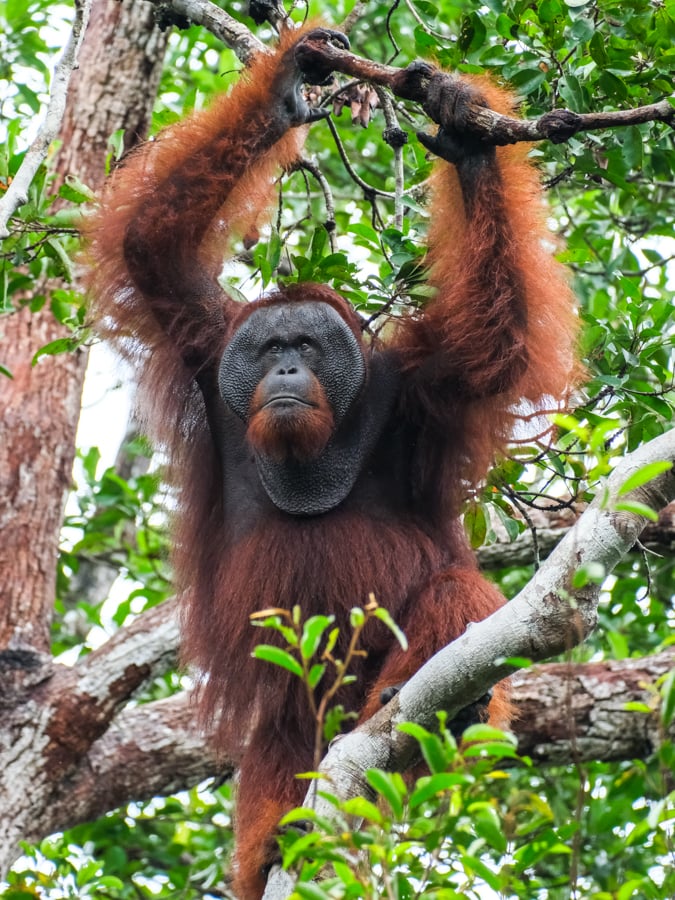
Big orangutan!
When To Visit Tanjung Puting National Park
The best time to visit Tanjung Puting depends on what you’re looking for.
During the dry season, from May to August, the weather is more sunny and temperatures are milder and cooler. This is the best weather for visiting Tanjung Puting since you’re less likely to get rained on.
Unfortunately, the dry season is also the high season, so the park can be a lot more crowded with boats and tourists. There can be up to 100 boats in the park at a time, and you may struggle to get an ideal spot at the feeding stations unless you show up before the crowd, although your guide can help with this.
During the rainy season, especially from November to April, the weather during the day can be hot and humid, at 32 to 35 °C (90 to 95 °F). There’s a lot more rain in these months, but the park is also much less crowded, and the rain is mostly at night.
We visited Tanjung Puting during the rainy season (late November) and had a great trip. There was a little bit of rain on the first day, and a huge downpour during the night, but we were able to stay dry in the boat so it didn’t really affect us.
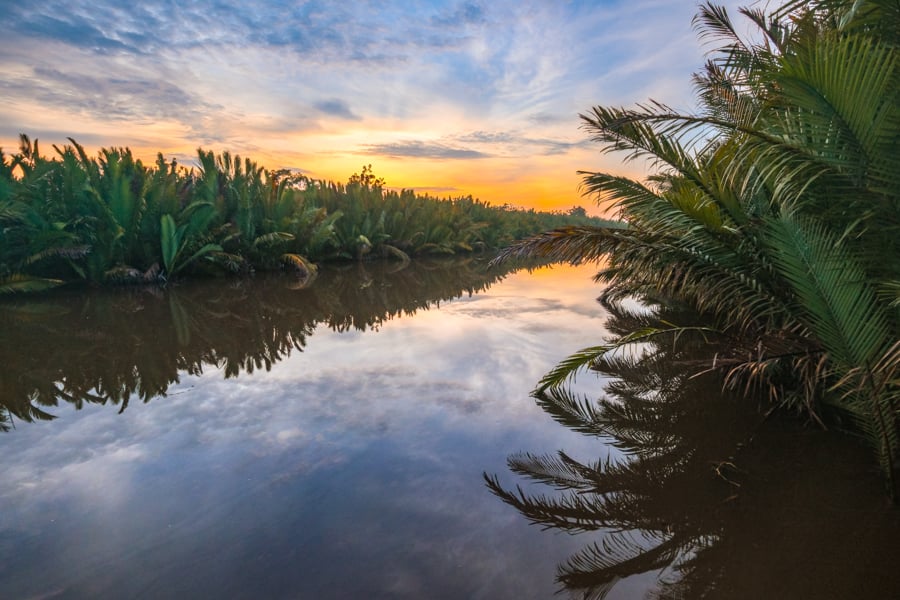
Sunrise on the Sekonyer river
More Indonesia Travel Tips
Thanks for looking! I hope you enjoyed this travel guide for visiting Tanjung Puting National Park in Kalimantan, Indonesia. We really enjoyed seeing the orangutans there.
Don’t forget to check out my complete guide for the best places to visit in Indonesia!
See Also
- Most Beautiful Indonesian Islands - Best Places To Visit In Indonesia
- Best Hikes In Indonesia - Volcanoes, Jungles, & Waterfalls
- Indonesia Waterfall Guide - Best Waterfalls In Indonesia
- Indonesia Beach Guide - Best Beaches In Indonesia
- Best Things To Do In Indonesia - What To Do In The Islands
- Indonesia Travel Guide - Tips, Info, & Photos